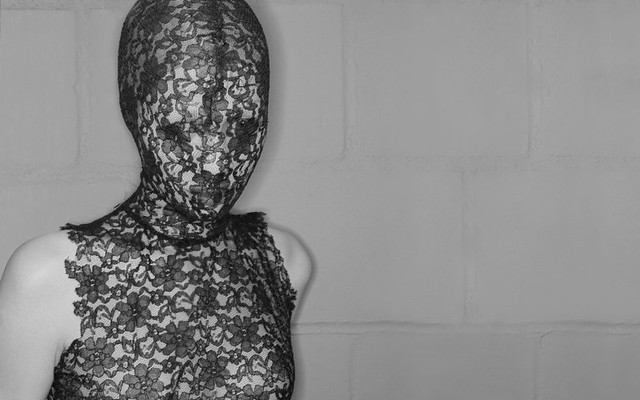Maddie Salters reports: Stepping off the elevator into The Gallery on the fifth floor of Foyles booksellers at Charing Cross, a curiosity awaits. The usually timid space that shepherds people off to the uptempo cafe and wine bar beside it has grown into something remarkable. A landscape of gargantuan black and white photographs with irrepressible imagery that commands attention. Enter the Inferno.
Inferno is an intimate look into the back rooms and makeshift vanity tables in Christchurch, Spitalfields circa 1996, where Alexander McQueen readied his runway models for a show-stopping catwalk through the ancient Church’s stained-glass main hall, in a feast for the eyes and senses that would change the fashion world forever. While the runway itself, candle lit and brimming with inspiration from Dante’s “The Divine Comedy,” showed off a playful sense of theatricality and irony in its juxtaposition of location and theme, what the shows’ backstage photographs give us is a real glimpse of what the models later played at: the pleasure, pain, and vice of an Alexander McQueen show.
Curated expertly by Olly Walker and Futurecity, the photographs by Kent Baker are on display for the first time ever. Shot entirely on black and white film, they bare all the dynamism of film photography’s ability to capture a moment: blurred lines of motion, half-formed expressions, powerful contrast. The unprocessed medium, it turns out, was the best medium to show McQueen’s process.
The spectacle is stunning. In the photographs, we see an easy hedonism and a lazy sex appeal that overcomes concepts of gender. The models are fluid, and their expressions are naked, even as they are adorned with masks and noosed hair extensions. Everything is in contrast, not just the prints. There is vulnerability on the face of one woman, her hands pressed together and her eyes downcast as if in prayer, but with the fabric of her sleeves nervously bunched to prevent that true touching of palms. Confidence oozes off of an adjacent portrait, where the model is irreverent of the photographer, owning her space, dark-eyed, dark-lipped, and arch browed. Each subject evokes a powerful narrative: curiosity, coltishness, joviality. Moments are captured: a hug, a laugh, a conversation. Poses are struck: tongues out, arms akimbo. And in the background of some frames stands Lee McQueen himself, overseeing his story.
What about this collection makes it so powerful? As Lee’s quote, painted onto the wall, states: “The shows are about what’s buried in people’s psyches.” Describing himself as a melancholic romantic, his aesthetic belays itself here. The models are wearing his clothes, and no matter how outlandish, their personalities shine through first, and the accessories remain just that. He has found the beauty in the vice in people’s selves, as much as he has sewn it into his creations. The McQueen crowd is irrepressibly young and daring, wearing jackets with soldiers, starving children, and the faces of old men emblazoned on them. The everyday evils and every day infernos we experience, or ignore, carried in couture seams.
What really struck me about these photographs on a second walk through the gallery was their composition. The devil is in the details, so to speak. Engross yourself in the minutia of each shot, and McQueen’s backstage space comes to life. Open champagne bottles, coca-cola cans, and barbells sit on the floor. The subjects are bald, have tattoos, eyebrow studs, unshaven arms, or smoke cigarettes. Graffiti, cartoon bubbles, paper litter, restroom signs, and cracked floors are the backdrop to their raised brows and painted faces. Q-tips are left to pile on the floor, the rushed waste that has helped to create flawless facades. You view these images knowing that those who sat in the front row only ever saw the end product. Here, in these photos, is the hidden psyche McQueen spoke of.
I was lucky enough to be given a tour of the memorabilia wall by Olly Walker himself. Plastered against one side of the gallery, it is a riot of original contact sheets, tickets to the Christchurch show, the runway lineup, press sketches, and more. This gives a glimpse into what the book, Inferno: Alexander McQueen, released alongside the exhibit, contains. By Kent Baker and Melanie Rickey, the highlight of the publication is the scanned versions of the original runway clothes, now housed in the United States. They give a sensation of the texture and weight of the clothes worn by the models and adeptly crafted by McQueen.
Inferno is a peek into the power of fashion as an art and its indelible ability to create social thought movements. Here, on un-retouched photographs ablaze with fluorescent luminosity and a moody tonality, there is no celebration of false luxury. Instead, we see what fashion can be: the every day, pushing limits while still being second to the wearers themselves, dark, but ordinary in their darkness. That’s what the “Divine Comedy” was, after all: bringing into the light what we demonise, and seeing in ourselves truth, however unpleasant. The show is contemporary even now, and radical as it brings a moment of peaceful revolution loudly into the forefront at last.
Inferno is on until May 3rd. Limited prints of the works are available. Find it in The Gallery, Foyles, 5th Floor, 107 Charing Cross Road, WC2H 0EB. Go to foyles.co.uk/Inferno-Alexander-McQueen for more details.






















